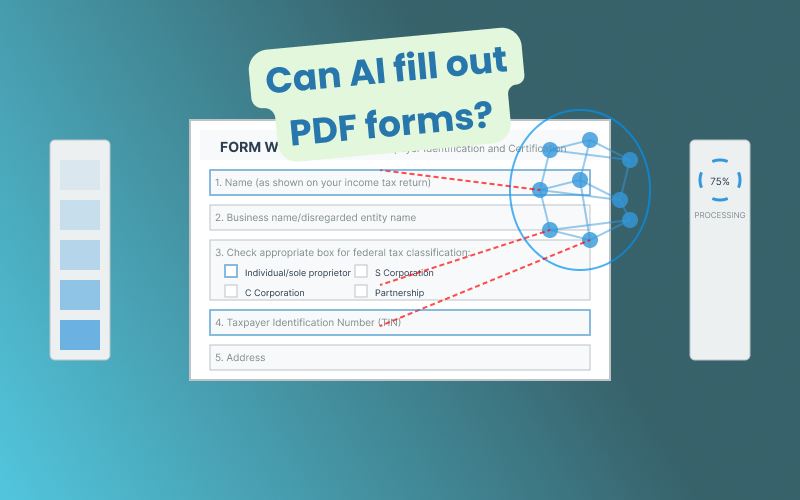AI form filler technology, especially generative AI and large language models (LLMs), has reached a point where it can reliably automate the process of filling out complex forms. Recent advancements allow businesses and individuals to significantly streamline form filling processes, often eliminating extensive manual efforts.
Why AI is Now Capable of Filling Out Forms
Powerful Contextual Understanding
The rise of sophisticated LLMs like GPT-4.5 means AI can comprehend context, interpret complex language, and extract relevant data without explicit rules. These models have been trained on massive datasets, enabling them to understand nuances and context, vastly reducing the need for rigid templates or keyword matching.
Handling Unstructured Data with Large Context Windows
Modern LLMs now boast context windows ranging from 32,000 up to 128,000 tokens. This enables AI to process large, unstructured datasets such as lengthy documents, medical records, financial reports, or complex user profiles in a single step. The increased capacity means AI can keep more relevant context at once, making form filling both faster and more accurate.
Efficient Processing of Long and Complex Forms
Today’s AI tools comfortably handle extensive forms with dozens or even hundreds of fields. Forms like detailed insurance applications, tax documents, mortgage paperwork, or complex government forms can now be completed quickly. AI pdf form filler software, such as Instafill.ai, leverages these capabilities, automatically extracting data from uploaded documents and populating relevant fields without manual input.
Leveraging RAG and Vector Databases for Efficient Instruction Handling
Complex forms often come with extensive instructions. For instance, IRS tax forms have pages of instructions. AI solutions effectively handle this through Retrieval-Augmented Generation (RAG):
- Long documents are split into smaller, indexed chunks.
- Each chunk is stored within a vector database.
- AI retrieves only the chunks necessary to complete specific sections or fields.
This makes the filling process fast, accurate, and scalable.
Challenges and Pitfalls
While AI form-filling has dramatically improved, several key challenges persist:
Accuracy and Reliability
AI still occasionally makes mistakes:
- Misinterpretation: AI may misunderstand the intent behind form fields, particularly when instructions or context are unclear.
- Hallucination: AI occasionally generates plausible but inaccurate data when it misunderstands source material.
Regulatory Compliance and Data Security
AI-powered form filling must strictly adhere to regulations such as GDPR, HIPAA, or financial industry standards. AI software must ensure data privacy, security, and maintain transparent records of how decisions were made, which can be challenging.
Technical and Structural Issues
Forms Without Instructions or Metadata
Some PDF forms contain little to no guidance or descriptive metadata, making it difficult for AI to determine what information each field requires. Without clear instructions or field labels, AI relies solely on layout inference and context, leading to potential inaccuracies.
Multiple Lines for a Single Logical Field
Fields that span multiple lines of text can confuse AI. Visually, it appears as one logical field, but technically, it might be implemented as several fields. This can lead to incorrect or incomplete data entry unless specifically accounted for by custom logic or additional human validation.
Ambiguity and Lack of Metadata
Forms often have ambiguous or similar-looking fields without clear labeling or metadata, forcing AI to guess contextually. In cases where metadata or clear field labels are missing, the AI must rely solely on contextual clues, increasing the risk of mistakes.
Multiple Values for a Single Field
Unstructured data frequently contains multiple instances of the same logical data type—like multiple addresses, names, or phone numbers. Deciding which value should populate a given field can be challenging for AI, requiring human review or advanced selection logic based on context.
PDF-specific Challenges
PDF Forms Without Metadata
PDF forms often lack embedded metadata or clear instructions. Without contextual clues or proper labels, AI must interpret fields based purely on proximity, layout, and visual context, increasing the likelihood of error.
Handling XFA PDFs
Some PDF forms use XML Forms Architecture (XFA), dynamically separating content from layout. XFA forms allow users to dynamically add or remove fields, making them particularly challenging for AI software to parse. Standard extraction libraries struggle with XFA, often requiring specialized preprocessing.
Cost Considerations
Implementing robust AI form filler solutions can be costly due to reliance on expensive reasoning models like OpenAI GPT-4.5, o3-high or DeepSeek R1. These powerful models, essential for accurate form filling, require substantial computational resources, potentially increasing operational expenses significantly.
How to Mitigate These Challenges
Addressing these issues requires careful strategy:
- Human-in-the-Loop (HITL): Combining AI with human oversight ensures accuracy and mitigates risks from ambiguous fields or regulatory compliance.
- Advanced Parsing Techniques: Specialized tools capable of handling complex PDF forms (like XFA) can enhance data accuracy.
- Enhanced Validation and Data Verification: Building explicit validation mechanisms and structured data verification into the AI workflow reduces errors.
- Explainable AI: Implementing transparency in AI decision-making helps compliance, trust, and user acceptance.
Leveraging AI Form Filling in Practice
With careful implementation, generative AI and platforms like Instafill form filler significantly improve efficiency, accuracy, and scalability in form filling. Despite existing challenges, the productivity gains, accuracy improvements, and cost savings make the adoption of AI-powered form filling compelling and valuable for modern organizations.
Quick Demonstration: Filling Out IRS Form W-9
For a real-world glimpse of these capabilities in action, check out this video tutorial:
The future of form filling is increasingly automated—and generative AI is leading the charge.
To explore automated form filling with AI, visit Instafill.ai.
